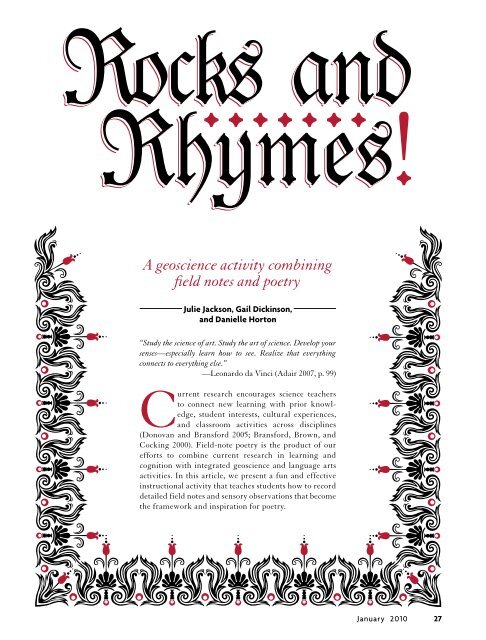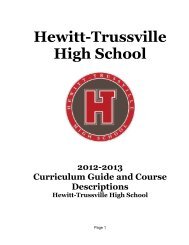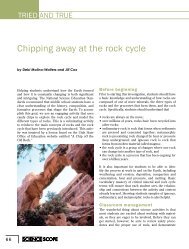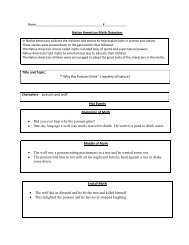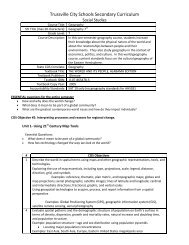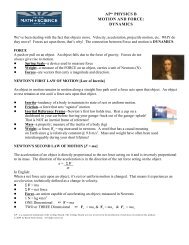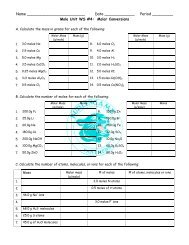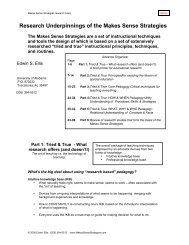A geoscience activity combining field notes and poetry
A geoscience activity combining field notes and poetry
A geoscience activity combining field notes and poetry
Create successful ePaper yourself
Turn your PDF publications into a flip-book with our unique Google optimized e-Paper software.
A <strong>geoscience</strong> <strong>activity</strong> <strong>combining</strong><br />
<strong>field</strong> <strong>notes</strong> <strong>and</strong> <strong>poetry</strong><br />
Julie Jackson, Gail Dickinson,<br />
<strong>and</strong> Danielle Horton<br />
“Study the science of art. Study the art of science. Develop your<br />
senses—especially learn how to see. Realize that everything<br />
connects to everything else.”<br />
—Leonardo da Vinci (Adair 2007, p. 99)<br />
Current research encourages science teachers<br />
to connect new learning with prior knowledge,<br />
student interests, cultural experiences,<br />
<strong>and</strong> classroom activities across disciplines<br />
(Donovan <strong>and</strong> Bransford 2005; Bransford, Brown, <strong>and</strong><br />
Cocking 2000). Field-note <strong>poetry</strong> is the product of our<br />
efforts to combine current research in learning <strong>and</strong><br />
cognition with integrated <strong>geoscience</strong> <strong>and</strong> language arts<br />
activities. In this article, we present a fun <strong>and</strong> effective<br />
instructional <strong>activity</strong> that teaches students how to record<br />
detailed <strong>field</strong> <strong>notes</strong> <strong>and</strong> sensory observations that become<br />
the framework <strong>and</strong> inspiration for <strong>poetry</strong>.<br />
January 2010 27
Looking at the world: Observation<br />
Making observations is an important science-process skill,<br />
<strong>and</strong> gathering evidence from observations is a key element<br />
of inquiry (NRC 2000). The National Science Education<br />
St<strong>and</strong>ards state that when direct experimentation is not<br />
possible, “it is important to maintain the spirit of inquiry<br />
by focusing the teaching on questions that can be answered<br />
. . .using observational data” (NRC 2000, p. 189). Because<br />
many <strong>geoscience</strong> concepts are not accessible via experimentation,<br />
geoscientists value observational evidence. As a result,<br />
students must move beyond simply looking at objects<br />
<strong>and</strong> learn to make high-quality observations. In observation<br />
activities, this transition occurs when teachers begin a lesson<br />
with basic tasks <strong>and</strong> gradually include more complex visualization<br />
tasks in combination with open-ended questions<br />
<strong>and</strong> qualitative expressions.<br />
Journaling in nature<br />
Recordkeeping is a fundamental element of scientific investigations,<br />
<strong>and</strong> scientists use <strong>field</strong> <strong>notes</strong> to record their observations<br />
while working outside. Field <strong>notes</strong> can range in<br />
style from structured to free form, <strong>and</strong> they should include<br />
the date, time, weather conditions, <strong>and</strong> location in each entry.<br />
They also frequently include lists of observations, measurements,<br />
<strong>and</strong> sketches.<br />
The <strong>field</strong>-note <strong>poetry</strong> exercise in this article uses semistructured<br />
<strong>field</strong>-note entries <strong>and</strong> can be used in any outside<br />
location that supports instruction, such as a pond, <strong>field</strong>, local<br />
park, or flower garden.<br />
Scaffolding observation<br />
oppor tunities<br />
The art of observation begins when we immerse ourselves<br />
in the surrounding textures <strong>and</strong> tones of life (Dunleavy<br />
2008). Observational skills improve with practice, <strong>and</strong><br />
teachers should strive to provide students with opportunities<br />
to make observations. We start with a familiar locale for<br />
students: our school grounds. Students begin the <strong>field</strong>-note<br />
<strong>poetry</strong> <strong>activity</strong> by recording basic information in their <strong>field</strong><br />
<strong>notes</strong>—such as site location, date, time of day, temperature,<br />
<strong>and</strong> weather conditions—<strong>and</strong> noting anything unusual.<br />
Next, we ask students to describe the topography, types<br />
<strong>and</strong> distribution of vegetation, location <strong>and</strong> types of water<br />
sources, <strong>and</strong> the flow rates <strong>and</strong> quantity of water. We also<br />
ask them to note the<br />
u<br />
u<br />
u<br />
u<br />
location <strong>and</strong> types of human influences;<br />
location, types, <strong>and</strong> interactions of wildlife;<br />
evidence of wildlife (e.g., prints, scat); <strong>and</strong><br />
types of rocks <strong>and</strong> evidence of their weathering <strong>and</strong> erosion.<br />
Students then draw a “T” chart in their notebooks. One<br />
side of this chart is labeled “What I see” <strong>and</strong> the other is<br />
labeled “What I hear” (Figure 1). We give students 5–10<br />
minutes to record their visual observations <strong>and</strong> another 5–10<br />
minutes to record their auditory observations.<br />
Beginning with a well-known location highlights the<br />
difference between a casual glance <strong>and</strong> scientific observations.<br />
Students are generally surprised by the details they notice<br />
when given an opportunity to study a place that they<br />
encounter daily. After this experience on campus, students are<br />
better prepared to make observations off school grounds.<br />
When students are given structured opportunities that<br />
allow them to observe nature <strong>and</strong> record their findings, their<br />
perceptions evolve <strong>and</strong> change. Following several observation<br />
activities, one student said:<br />
The ability to see <strong>and</strong> feel the geology of the natural world<br />
has changed the way that I look at l<strong>and</strong>forms. When I see<br />
a mountain range, I now think of the millions of years of<br />
plate collisions that formed the chain <strong>and</strong> the millions of<br />
years necessary to completely erode the mountains.<br />
Sketching in nature<br />
As Barrett Klien, a preparer <strong>and</strong> display maker in the Exhibition<br />
Department at the American Museum of Natural<br />
History, said:<br />
The best way for any scientist to underst<strong>and</strong> his or her<br />
science is through visualization…Close observation is the<br />
first step in any scientific inquiry, <strong>and</strong> to my mind, there<br />
is no better way to observe than to try to draw what you<br />
are looking at (AMNH 2001).<br />
Figure 1<br />
Sample “T” chart.<br />
What I see<br />
Flowing river<br />
People<br />
Leaves blowing<br />
The Sun<br />
A water snake<br />
Mountains<br />
Columnar basalt<br />
Dirt<br />
Rocks <strong>and</strong> pebbles<br />
Clouds<br />
Blue sky<br />
Bugs<br />
Grass<br />
Weeds<br />
What I hear<br />
Flowing water<br />
Wind blowing leaves<br />
Rocks being stepped on<br />
Birds chirping<br />
Cars moving (traffic)<br />
People talking<br />
Leaves rustling<br />
28<br />
The Science Teacher
Rocks <strong>and</strong> Rhymes!<br />
Photos courtesy of the author<br />
Scientists use <strong>field</strong> sketches to enhance their observations<br />
<strong>and</strong> to develop ideas about the processes that have shaped the<br />
environment—we encourage our students to do the same in<br />
this <strong>activity</strong>. After they have completed their T charts, they<br />
sketch their observations. For example, one student may<br />
draw a broad l<strong>and</strong>scape picture showing his or her position<br />
within the setting, <strong>and</strong> another may draw a rock or a plant.<br />
Sketching exercises should allow sufficient time for students to<br />
concentrate on <strong>and</strong> interpret their surroundings without input<br />
from other sources, such as their textbooks, teacher, or peers.<br />
Once students have completed their individual sketches,<br />
they choose their own small groups <strong>and</strong> work with their<br />
group members to compare <strong>notes</strong> <strong>and</strong> produce a consolidated<br />
description <strong>and</strong> sketch. We have found this produces more<br />
detailed site descriptions <strong>and</strong> makes students aware of details<br />
they may have failed to observe individually.<br />
We then ask student groups to explain their drawings<br />
in a class discussion. We like to have individual students<br />
explain what they have observed through their sketches.<br />
Continually asking students broad questions—such as,<br />
What processes have contributed to this l<strong>and</strong>scape? What<br />
patterns do you see? Are there relationships between the<br />
distribution of the rocks, soils, <strong>and</strong> plants?—forces them to<br />
carefully observe their surroundings <strong>and</strong> look for evidence<br />
to answer these questions.<br />
After grading the groups’ site descriptions, we provide<br />
students with anonymous examples that illustrate novice- <strong>and</strong><br />
expert-level observations. We then ask them to compare <strong>and</strong><br />
contrast the two examples—further reinforcing the skills<br />
needed to produce high-quality work.<br />
Writing <strong>poetry</strong><br />
Once students have made their observations, created a<br />
journal entry, <strong>and</strong> drawn their <strong>field</strong> sketches, they then<br />
construct poems using these various pieces. Because<br />
there are many styles of <strong>poetry</strong> <strong>and</strong> different types of<br />
poetic structures, we discuss acceptable parameters before<br />
beginning our <strong>field</strong>-note <strong>poetry</strong> assignment. Figure<br />
2, “Poetry 101,” contains a list of common <strong>poetry</strong> styles<br />
that may be used to support <strong>field</strong>-note <strong>poetry</strong> activities.<br />
Student poems do not have to include large words or<br />
F i g u r e 2<br />
Poetry 101 (Ghare 2007; Poetry Magic 2009).<br />
Poetic<br />
structure<br />
Acrostic<br />
<strong>poetry</strong><br />
Alliteration<br />
Cinquain<br />
Couplet<br />
Description<br />
A form of short verse constructed so that the beginning letters of each line form words when<br />
taken consecutively.<br />
The repetition of consonant sounds in words near each other.<br />
Made up of five lines. The first line is one word; the second line contains two words that describe<br />
the first line. The third line has three words, <strong>and</strong> the fourth line has four words. The fifth<br />
line has one word that is the same word used in the first line.<br />
Stanzas contain two lines that rhyme with each other.<br />
Free verse<br />
Haiku<br />
Does not follow any structure or style. It is patterned by speech <strong>and</strong> images rather than by regular<br />
metrical schemes.<br />
Requires three sentences containing five, seven, <strong>and</strong> five syllables, respectively. The sentences do<br />
not need to rhyme. Traditionally, haiku includes references to nature.<br />
Quatrain Four lines in a stanza. The second <strong>and</strong> fourth lines rhyme <strong>and</strong> have similar syllable structures.<br />
Terza rima<br />
A verse form composed of iambic tercets (three-line groupings). The second line of each tercet sets<br />
the rhyme for the following tercet, thus linking the stanzas. The rhyme scheme is “aba bcb cdc…”<br />
January 2010 29
sophisticated vocabulary to be accepted (Linaberger<br />
2004). We do not specify a particular format for our<br />
<strong>poetry</strong> assignment—they do not need to follow a fixed<br />
meter, rhythm, or pattern. As a result, students turn in<br />
poems that range from simple, four-sentence rhymes to<br />
complex, multiverse constructions.<br />
A quick conversation with a language arts teacher can<br />
easily focus the poem structure on a type of <strong>poetry</strong> taught<br />
in students’ English classes. This alignment of expectations<br />
<strong>and</strong> assignments across content areas may increase student<br />
participation while providing time to develop high-quality<br />
poems. Students can also choose to publish their <strong>poetry</strong> online<br />
or enter it in the annual science <strong>poetry</strong> contest sponsored by<br />
the Science Education Review (see “On the web”).<br />
Putting it all together<br />
One of our <strong>field</strong>-note <strong>poetry</strong> activities took place off campus,<br />
just east of the Cascade Mountains, in a picnic area<br />
facing an outcrop that exposes several layers of columnar<br />
basalt. This <strong>field</strong> site borders a small stream to the west<br />
<strong>and</strong> a two-lane state highway to the east. This was the first<br />
time our students had been here. They drew T charts in<br />
their <strong>field</strong> notebooks; made sensory observations; <strong>and</strong> drew<br />
sketches of the outcrop. Using their observations, they then<br />
wrote their own poems; a sample student poem is shown<br />
in Figure 3.<br />
Poetry is the creative expression of thought—<strong>and</strong><br />
a medium for students to organize their thoughts <strong>and</strong><br />
impressions. Field-note <strong>poetry</strong> provides teachers with insight<br />
into their students’ content knowledge development, while<br />
showcasing emergent perceptions <strong>and</strong> evolving attitudes<br />
about scientific concepts <strong>and</strong> processes. For example, one of<br />
our students came to recognize that Earth scientists view the<br />
world differently—<strong>and</strong> value that difference:<br />
Take a normal person with normal views<br />
Turn on the mind of a geologist<br />
And the Earth breathes life…<br />
Ignorance is not always bliss.<br />
William Cullen Bryant (Wilson 1991; p. 121) said that<br />
“<strong>poetry</strong> is that art which selects <strong>and</strong> arranges the symbols of<br />
thought in such a manner as to excite the imagination the most<br />
powerfully <strong>and</strong> delightfully.” The National Science Education<br />
St<strong>and</strong>ards encourage students to showcase science in “a variety<br />
of ways, such as orally, in writing, <strong>and</strong> in other forms” (NRC<br />
2000, p. 192). Student poems reveal levels of creativity <strong>and</strong><br />
depth of underst<strong>and</strong>ing that cannot be expressed in traditional<br />
science reports or structured science notebooks.<br />
Figure 3<br />
Sample student poem.<br />
The Story<br />
I see debris on the outcrops<br />
Columnar joints of basalt like nature’s art sculptures<br />
I see the easy flow of a river<br />
Tiny rocks between my feet<br />
Patches of yellow <strong>and</strong> green grass<br />
Little shrubs struggling for sunshine in the heat waves<br />
Radiating through<br />
I hear the beat of running water<br />
Bugs chirping<br />
Nature at work<br />
I hear my feet cracking underneath<br />
The rocks as I try to figure out the story of what<br />
happened here<br />
I ask myself…<br />
A lava flow, what caused it?<br />
Geothermal heat? An earthquake?<br />
I see the clues of the past in the rocks<br />
In the banks<br />
In nature all around<br />
Then I hear the roar of cars<br />
Breaking my serene silence<br />
My story of the l<strong>and</strong> disappearing<br />
My concentration broken<br />
But not my will to do this job<br />
Not my will to help the world<br />
Nor discover its hidden mystery<br />
Figure 4<br />
Field-note <strong>poetry</strong> rubric.<br />
3 points 2 points 1 point<br />
Science<br />
content<br />
knowledge<br />
Excellent underst<strong>and</strong>ing<br />
<strong>and</strong> application of science<br />
content<br />
Good underst<strong>and</strong>ing <strong>and</strong> application<br />
of science content<br />
Poor underst<strong>and</strong>ing <strong>and</strong><br />
application of science<br />
content<br />
Sensory images Vivid, detailed sensory images Clear use of sensory images Some use of sensory image<br />
Use of<br />
language<br />
Uses rich <strong>and</strong> imaginative<br />
language<br />
Appropriate choice of<br />
language<br />
Imprecise or inappropriate<br />
choice of words<br />
30<br />
The Science Teacher
Rocks <strong>and</strong> Rhymes!<br />
Assessing the <strong>activity</strong><br />
Formative assessments are embedded in daily instructional<br />
activities, such as <strong>field</strong> <strong>notes</strong>, sketches, sensory observations,<br />
<strong>and</strong> answers to open-ended questions. These flexible<br />
assignments are used for immediate insight into students’<br />
developing ideas <strong>and</strong> to determine whether learning objectives<br />
have been achieved. Poems are interpreted in light of<br />
previous formative assessments. For example, the student’s<br />
ability to distinguish rhyolite from basalt, or identify columnar<br />
joints is measured in a lab practical. Students learn<br />
to analyze <strong>and</strong> predict the sequence of events in the rock<br />
cycle. Poems are also assessed using a rubric (Figure 4) to<br />
gauge three key poem attributes: science content knowledge,<br />
sensory images, <strong>and</strong> the use of language.<br />
A new way to see the world<br />
Poetry is a unique <strong>and</strong> powerful way of exploring <strong>and</strong><br />
knowing the world. It is a creative vehicle that students can<br />
use to “explore <strong>and</strong> express…the qualitative dimensions of<br />
experience” (Wilhelm 2009), while deepening their underst<strong>and</strong>ing.<br />
Because poems frequently rely on imagery <strong>and</strong><br />
word association, they provide students with a creative <strong>and</strong><br />
imaginative application of observational data. They also reinforce<br />
science vocabulary (Cabrera 2008).<br />
Field-note <strong>poetry</strong> forges interdisciplinary connections<br />
by <strong>combining</strong> knowledge of <strong>poetry</strong> structures <strong>and</strong> science<br />
content. Supporting activities provide opportunities for<br />
students to make observations <strong>and</strong> qualitatively express<br />
developing knowledge through semistructured <strong>field</strong> <strong>notes</strong>,<br />
sketches, <strong>and</strong> sensory observations. In combination, these<br />
engaging, cross-curricular, instructional techniques facilitate<br />
learning <strong>and</strong> engage students while transforming the<br />
classroom experiences of both teachers <strong>and</strong> students. ■<br />
Julie Jackson (jj32@txstate.edu) <strong>and</strong> Gail Dickinson (dickinson@<br />
txstate.edu) are assistant professors at Texas State University–<br />
San Marcos; Danielle Horton (dhorton@jsg.utexas.edu) is a<br />
program coordinator for the Jackson School of Geosciences at<br />
the University of Texas at Austin.<br />
Acknowledgment<br />
The authors would like to thank GeoFORCE Texas for supporting<br />
<strong>field</strong>-note <strong>poetry</strong> activities.<br />
On the web<br />
Science Education Review 2010 International Science Poetry<br />
Competition: www.scienceeducationreview.com/poetcomp.html<br />
References<br />
Adair, J. 2007 The art of creative thinking. Philadelphia: Kogan<br />
Press.<br />
American Museum of Natural History (AMNH). 2001. Drawing<br />
as a way of looking at the natural world. www.amnh.org/<br />
education/resources/rfl/pdf/drawing_as_a_way.pdf<br />
Bransford, J.D., A.L. Brown, <strong>and</strong> R.R. Cocking, eds. 2000. How<br />
people learn. Washington, DC: National Academies Press.<br />
Cabrera, M. 2008. The <strong>poetry</strong> of science: The effects of using<br />
<strong>poetry</strong> in a middle school ELD science classroom. The Electronic<br />
Journal of Literacy through Science 7 (1): 1–42. http://ejlts.<br />
ucdavis.edu/article/2008/7/1/<strong>poetry</strong>-science-effects-using-<strong>poetry</strong>middle-school-eld-science-classroom<br />
Donovan, S.M., <strong>and</strong> J. Bransford, eds. 2005. How people learn:<br />
Science in the classroom. Washington, DC: National Academies<br />
Press.<br />
Dunleavy, D. 2008. Mastering the art of observation. http://rising.<br />
blackstar.com/mastering-the-art-of-observation.html<br />
Ghare, M. 2007. Types of <strong>poetry</strong>: All the different types of poems.<br />
http://buzzle.com/articles/types-of-<strong>poetry</strong>-all-the-differenttypes-of-poems.html<br />
Linaberger, M. 2004. Poetry top 10: A foolproof formula for<br />
teaching <strong>poetry</strong>. The Reading Teacher 58 (4): 366–372.<br />
National Research Council (NRC). 2000. Inquiry <strong>and</strong> the national<br />
science education st<strong>and</strong>ards. Washington, DC: National Academies<br />
Press.<br />
Poetry Magic. 2009. Imagery in <strong>poetry</strong>. www.<strong>poetry</strong>magic.co.uk/<br />
imagery.html<br />
Wilhelm, J.D. 2009. Poetry as a 21st century problem-solving<br />
pursuit! Voice From the Middle 16 (3): 40–42.<br />
Wilson, R. 1991. American sublime: The genealogy of a poetic genre.<br />
Madison, WI: University of Wisconsin Press.<br />
January 2010 31


